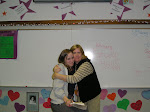Oh my goodness...where do I even begin?! Again, there are so many insightful and heartfelt testimonies in this diary. It truly is amazing how Erin Gruwell helped these teenagers who no one thought would make anything of themselves due to their environment, families, life styles, and stereotypes.
One part of this section of the book that I have to touch on is from Diary 57, p. 119-120. This student describes a "pep talk" Erin gave him after he had given himself an "F" in her class. She is pretty upset with this student and decided to tell him what it actually stands for. We all know what she said it stood for. I was pretty shocked that she said these exact words to the student, but I have to remember that each student is different and I have never walked in her shoes and tried to teach students who are living in the situations presented in this diary. However, that is not even the part that is interesting to me; the part that was truly interesting to me was the student's reaction. He starts out his diary by saying:
"Today I finally grasped the true meaning of self-reliance." After he has described what Erin told him he says, "No one in my life has ever given me facts so boldly. I never had a "pep talk" quite like this...what she showed me today is that a truly self reliant person takes action, leaving nothing to chance and everything to themselves. She showed me that excuses will not bring me about success and that adversity is not something you walk with, but something you leap over. The only obstacles are the ones you allow...I want to be a self-reliant person now and forever."
I was completely amazed by his reaction and what he learned from Erin. Although I can't see myself ever saying such words quite like she did to this student, it does inspire me to really make connections with my students and be real with them. This is what Erin did and she did get through to him. She told him what he needed to hear!
Another part that I must comment on is from Diary 85, p. 169-170. This part describes what a student saw and heard at the Holocaust Museum. As all of you know I do a unit on the Holocaust in my room and I think I am going to have to use this quote that the student had seen and wrote in the diary:
"They came for the trade unions, but I was not a trade unionist, so I didn't respond. Then they came for the Socialist, but I was not a Socialist, so I didn't respond. Then they came for the Jews and since I was not a Jew, I didn't respond. Then they came for me and there was no one left to speak out for me."
I teach every year that maybe a lot of the Holocaust could have been stopped if only people would have spoke up and refused to be silent. This quote really ties in with that! In fact, I could even share what this student said after reading this quote on a wall.
She says, "On our way back to the hotel, I saw Swastikas that we had covered. Before, if I saw something bad happen, I probably wouldn't have done anything. I used to think, 'If it doesn't affect me, why bother?' With the covering of the swastikas, and everything that happened today, I now know that there is not a day that will go by, when if I believe something is wrong, I won't do anything about it. It is better to take a chance and make a change, than it is to pass and pity."
Oh how I wish I had a chance for my students to go the Holocaust Museum. But, maybe I should look into it...Erin Gruwell probably would. ;) But, how unbelievably inspired is this student due to what she has read, seen, and heard?!
There are so many testimonies that I could touch on, but I think that it is essential that we do realize that these students did make the decision on their own to graduate in the end and that Erin was truly the inspiring instrument that they needed as guidance along the way. This book was fabulous, inspiring, and very motivational for teachers. I think that it could be very inspirational to other students as well. However, I would be careful about recommending it to certain age groups due to language, sexual references, and violence. I really wouldn't hesitate recommending it to high school students, but I would caution with some 8th grade students.
Fabulous! Fabulous Book!
Text Set: Literacy & Math
15 years ago



